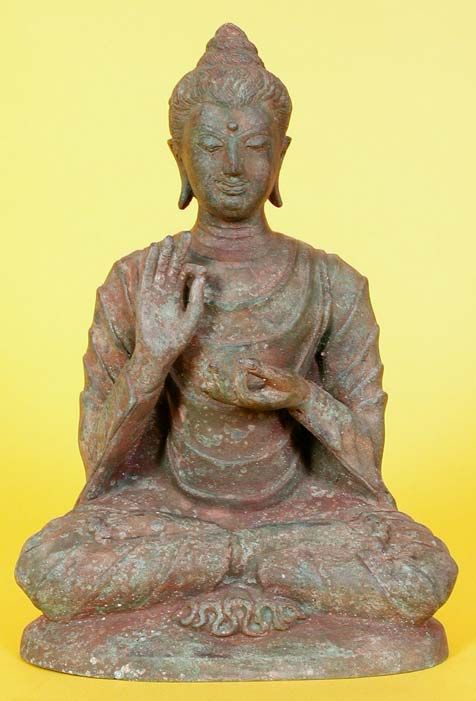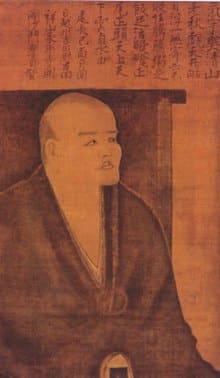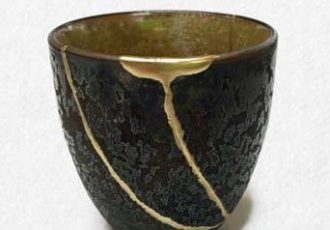If we know what to look for, we can tell the meaning of a Buddha Statue by looking at the pose / posture, and the accompanying hand gestures, called mudras. Each traditional pose has a significance related to an important event in the life – or past lives – of the Historical Buddha. Also referred to as an asana or an attitude, there are over 100 poses illustrating the life of the Buddha. Each posture will have a specific hand gesture associated with the posture, endowed with meanings and significance.
Protection Buddha / Overcoming Fear
The depiction of a seated Buddha with the right hand raised and facing outwards has two common meanings. The first is that of the Protection Buddha, as the raised right hand symbolically represents a shield. The second meaning, Overcoming Fear, is closely related to the first (since one who is receiving protection would be less fearful). The Buddha can be depicted either sitting or standing, and the left hand may either be extended outward or palm up in the lap. This statue signifies courage and offers protection from fear, delusion, and anger.
Meditation Buddha / Serenity Buddha / Calming Buddha
In this pose, the Buddha is depicted with both hands in the lap, face up, and the legs are crossed, either in a Double Lotus pose, or in a Single Lotus pose. Occasionally, an alms bowl is placed in the lap as well. As this statue generally represents focused concentration, the eyes of the Buddha are either depicted as halfway closed, or closed nearly all the way. The silhouette of the statue is shaped – more or less – like a triangle, which represents stability.This pose is also known as the Amithabha Buddha, which means “Boundless Light.”
Calling The Earth To Witness / Earth Touching Buddha
The most common pose of Buddha is with the legs crossed, the left hand in the lap, and the right hand pointing to the ground with the palm facing inward toward the Buddha. This posture is known as Calling The Earth to Witness, and it is the definition of the moment of enlightenment for the Buddha. It is the story of how the Buddha, after six years, finally was at the verge of enlightenment. Unfortunately, Mara, the Demon of Illusion, tried to dissuade The Buddha from the final last steps. The Buddha meditated all night to overcome the fears and temptations sent by Mara, and then called the Earth Goddess to witness that the Buddha achieved enlightenment in order to share with the rest of the world. Witnessing that, the Earth Goddess wrung her hair, releasing flood waters that swept away the Demon Mara and all the temptresses he had released.
The Nirvana Buddha / Reclining Buddha
This pose depicts the Historical Buddha in the last moments of life on earth, prior to the Buddha dying one last time before entering Nirvana (often written in English as ParaNirvana when referring to the life of The Buddha). Because the Buddha had gained enlightenment in this lifetime, the Buddha was able to escape the endless cycle of birth – death – rebirth (known as samsara) and was able to enter Nirvana. The Buddha is always depicted lying on the right hand side on top of a resting table.
Medicine Buddha
The Medicine Buddha is depicted in paintings having blue skin, but whether shown in statue or painted form, the right hand is held facing downward with fingers extended toward the ground, palm facing outward toward the viewer, a bowl of herbs rests in the left hand upon the lap. It is believed that the Buddha was responsible for delivering the knowledge of medicine to the people of the world, and in fact, the right hand facing outward signifies “granting a boon” (meaning, giving a blessing) to mankind. Generally, the Medicine Buddha is venerated by those seeking health.
Teaching Buddha / DharmaChakra Buddha
This pose signifies wisdom, understanding, and fulfilling destiny. Both hands are held at chest level, with thumb and index fingers forming a circle. The right hand is turned palm in, while the left hand is turned palm out. As do most images of the Buddha, the Teaching Buddha depicts a particular moment in the life of the Buddha, namely, the first sermon the Buddha gave after reaching Enlightenment. This sermon was to a small group of disciples who had previously scorned the Buddha. This Buddha is venerate by those who are either studying or are interested in learning more about spirituality.
The phrase DharmaChakra is hard to translate. The word Dharma means “the way of righteousness,” while the word Chakra is usually translated as the “Universe” or as the “cosmos.” Taken together, this phrase generally is interpreted as, “putting the cosmic law of righteousness in order,” or “turning the wheel of cosmic righteousness.”
Sukhothai Walking Buddha / Returning From Heaven Walking Buddha
Signifies grace and internal beauty. Right hand raised, facing outward, left hand dangles along left side of the body. Standing with right foot behind, starting to raise off the ground. This represents a time when the Buddha was returning to earth after delivering a sermon on the Dharma in Heaven, and was being accompanied by Lord Indra and Lord Brahma.
Contemplation Buddha
In this pose, both arms of the Buddha lie flat against the chest, the palms of both hands facing in, with right arm on the outside of the left arm. The Contemplation Buddha signifies quiet determination and patient understanding.
Alms Bowl Buddha / Begging Buddha
Arms bent at elbows, holding an alms bowl at chest level. This statue signifies compassion and caring for all beings. Contrary to what many think, monks (and the Buddha) did NOT beg for food. Instead, they collected alms. The difference is that collecting alms allows for those GIVING the alms to make merit (meaning, to acquire good karma). Devout Buddhists in Asia will prepare and give food to monks in the morning on their alms rounds.
Source, photo: thebuddhagarden




